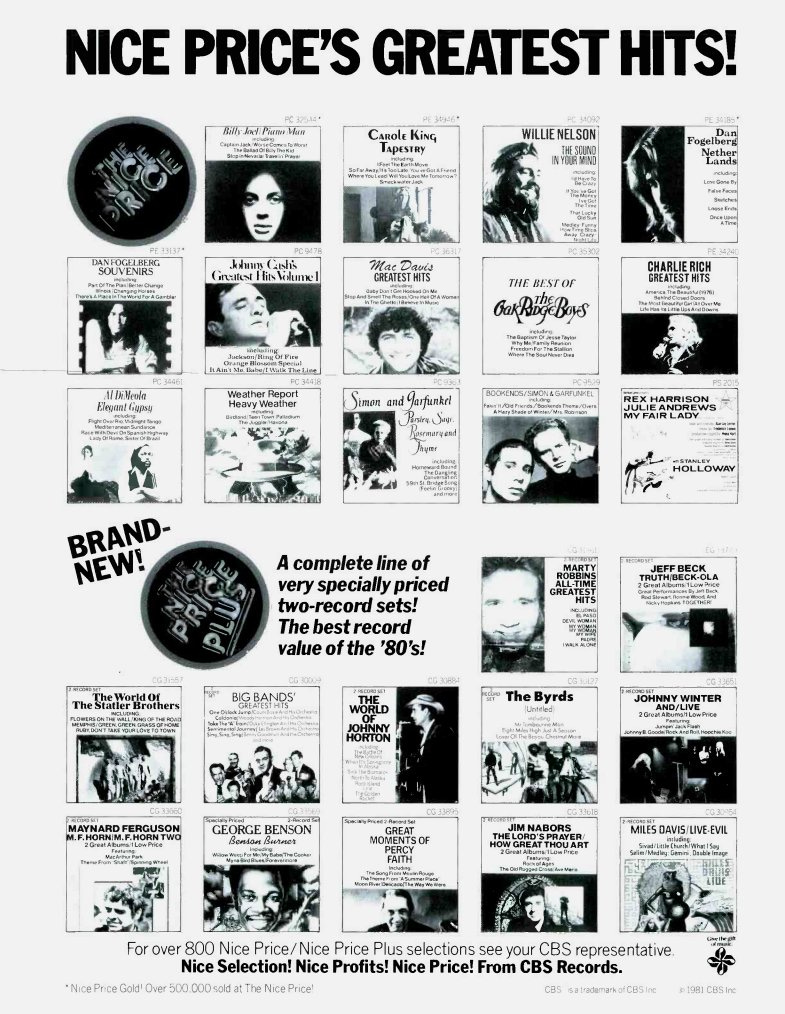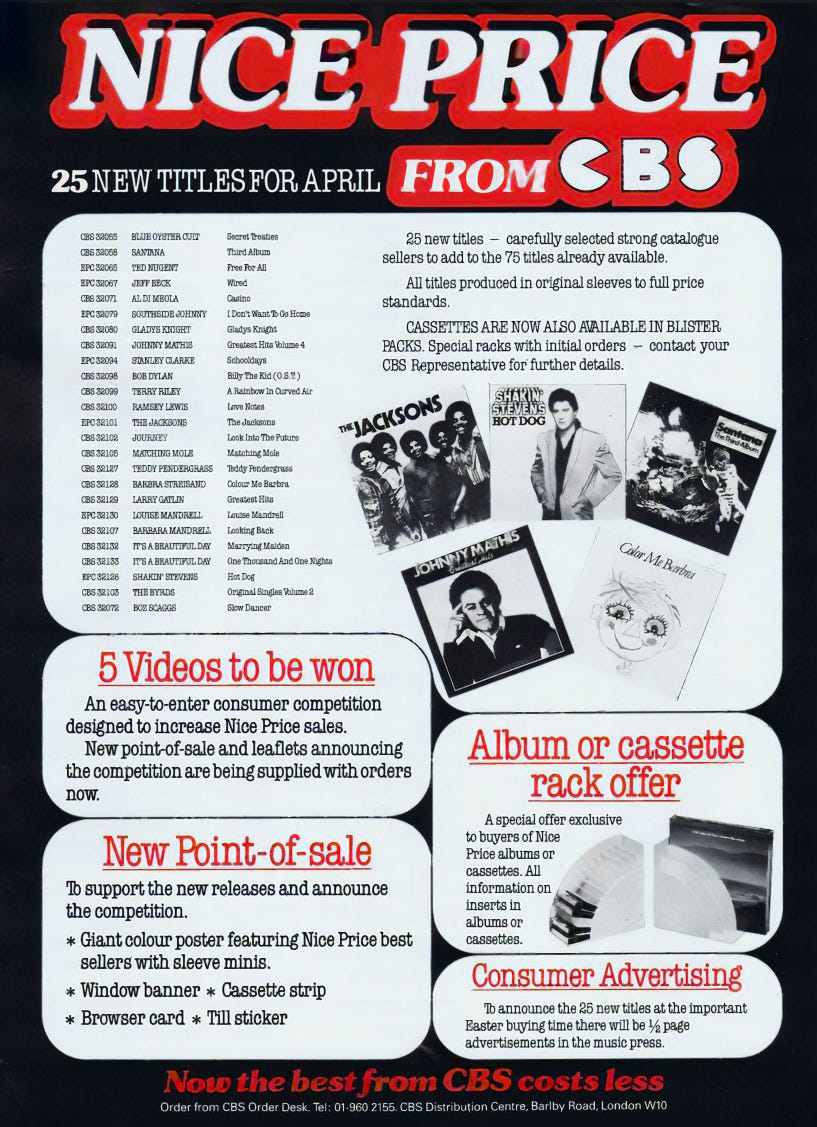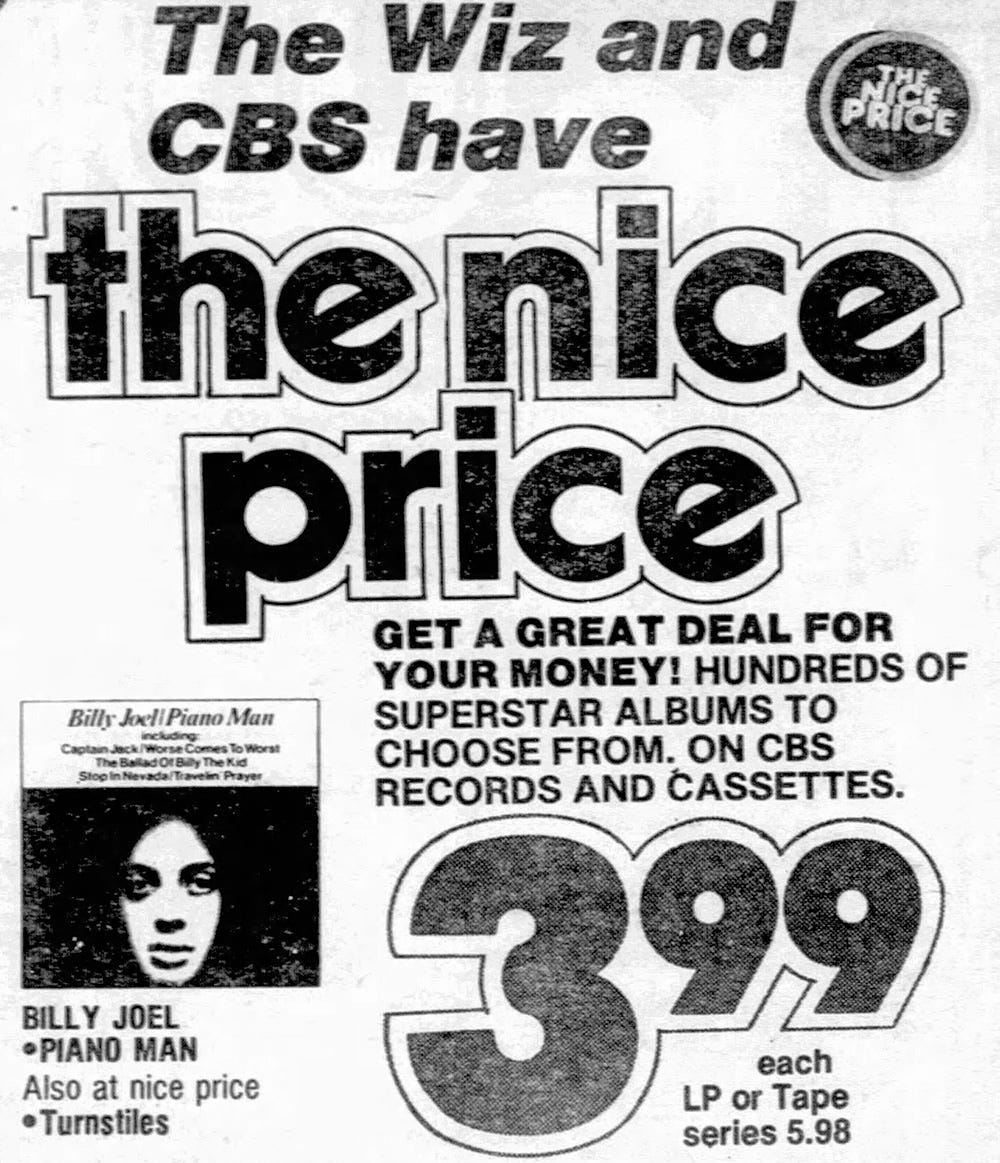
As a kid, I was pretty happy with the few albums I bought. With limited funds, it was important that I was sure the album I was picking up was going to be worth of multiple replays. Over time though, I started discover that you could buy albums at lower prices. Remaindered and used became my good friends, but another category existed for people who wanted brand new albums at lower prices. These were records, usually older hits that were send to record stores and meant to be sold at a discounted rate. They were usually branded as such and today I want to talk about one the more famous of these brands, The Nice Price.
When CBS Records introduced The Nice Price in the United States, it was not just about cheap records. It was a way to give older albums new life on store shelves at a lower cost. By the late seventies the company had decades of proven titles in its catalog from artists like Bob Dylan, Miles Davis, and Billy Joel. These albums had long ago covered their recording and promotion costs, but they were drifting out of sight in shops that needed room for new releases. The Nice Price program solved that problem by putting them back into circulation.
The program began in 1979 with about three hundred titles, and by 1981 the number had grown to eight hundred. A Billboard report that fall described the plan as a price cut across a block of albums, lowering list prices from the standard 9.29 to 6.98. That put them in a middle ground between full price new records and true bargain bin albums. The trade press positioned it as a midline strategy rather than a dump of unsold stock. These were healthy catalog titles, priced to sell while still leaving room for stores to make a profit.
In the United States the program was most visible on vinyl LPs. Nice Price albums usually carried a bright circular or rectangular sticker on the shrink wrap with the logo. Once the record was opened the difference was clear. Printed inner sleeves with photos or lyrics were often replaced with plain white sleeves. Heavier vinyl stock was sometimes swapped for thinner pressings. Extras such as posters or inserts were dropped. These cuts saved CBS production costs while still giving listeners the full album.
The stickers became a familiar sight in record stores. Anyone flipping through racks in the eighties and nineties recognized that red and yellow logo as a flag announcing that a solid classic album could be had for a couple of bucks less. The music was the same as the original and most buyers were happy to sacrifice bells and whistles for savings. The Nice Price was available in other countries as well, where the stickers looked different, but the reasoning behind them was the same.
Pricing was the heart of the program. By lowering the list price of Nice Price LPs to 6.98 from the usual 9.29, CBS gave some meaningful saving. At a time when a dollar or two made a huge difference for younger customers, that was enough to sway a purchaser like me.
The dealer margin was still solid. A 1981 report in Record Business noted that the UK version sold at 2.99 retail, giving shops about a thirty percent margin. The U.S. structure used different wholesale figures, but the principle was the same. Stores had reason to push these albums because they could sell them cheaply without cutting their profit. For smaller shops it was an advantage, since they could restock proven titles without tying up money in expensive imports or untested new releases.
This placed Nice Price albums in their own category. They were not as cheap or random as cutouts, which were often seen as failed records and could be identified by purposely damaged covers where a corner was clipped or a notch was sawed into the sleeve, a permanent reminder that the record had not sold. They were not as expensive as brand new full price LPs either. Nice Price struck a middle ground, giving CBS a way to present its back catalog as both valuable and accessible.
For a lot of us The Nice Price became the doorway into an artist’s history. A teenager in 1982 might have bought Born to Run at full price but then filled in the rest of Bruce Springsteen’s discography through Nice Price reissues. Fans of Dylan, The Clash, or Toto could suddenly explore large parts of their work with less of a cost barrier. The rise of cassette culture made this even more important. People were buying whole discographies to tape for their Walkmans, and Nice Price editions made that habit affordable. The line turned casual fans into collectors because it was much more reasonable to dig deeper than the hits.
Record stores often set up dedicated bins or racks for the series, making it easy to browse. That visual presence helped the branding stick, and you soon found yourself looking just for the stickers if you were on a budget. Especially once you figured out what the stickers meant.
CBS like other music companies, had catalog numbers for all their records. For The Nice Price, they set aside a dedicated range within their existing system to keep the program organized. In the United States many Nice Price LPs were placed in the 32000 block, usually from 32001 through the upper 32800s. This distinguished them from the original editions, which kept their first catalog numbers. For example, Planet Waves by Bob Dylan and Sounds of Silence by Simon and Garfunkel both appeared in this budget run. Planet Waves was the first Nice Price album (catalog 32001), followed by Simon and Garfunkel’s Sounds of Silence and Teddy Pendergrass’s Greatest Hits.
The purpose was practical. Retailers and distributors could order either the original full price release or the Nice Price edition, and the numbering kept billing, reorders, and chart tracking clear. For collectors today, the 32xxx series is often the surest way to identify a Nice Price pressing if the sticker is missing.
The same principle carried over to cassettes. Tape editions often mirrored the LP numbers but used a prefix to mark them as cassettes, keeping the program consistent across formats. Compact discs were handled differently.
By 1988 CBS Records had been folded into Sony Music and the industry was moving quickly into the CD era. The Nice Price branding carried through the transition. In the late 1980s and early 1990s the program was common on compact discs. CDs usually kept their original catalog numbers, but the cases carried a Nice Price sticker or logo on the tray card. The same logic of the vinyl program applied. Booklets were stripped down, packaging was simplified, and the savings were clear. In the expensive early years of the CD market, having a midline option helped. Sony used the program not only in the U.S. but across its international branches, and Japan continued issuing Nice Price CDs well into the 2000s.
The program grew quickly and was a big success. By mid 1981 trade papers reported that more than ten Nice Price titles were moving onto the album charts. CBS added titles steadily through the year, with fifteen more in June and another twenty five by September. By 1983 the U.S. program reportedly carried close to one thousand titles, covering nearly every major act on the label.
CBS also introduced The Nice Price Plus, a sticker applied to double albums and box sets. They looked different in color with a pink and purple theme. A Cash Box feature in February 1982 described these at a suggested retail around 8.98. That was still cheaper than normal double sets but high enough to reflect the added costs of producing them. It showed that CBS was willing to adapt the idea beyond single LPs.
Other labels had their own versions of The Nice Price. Warner had the Super Saver Series, RCA had the Best Buy Series, and MCA had Value Priced reissues. These worked for these companies but seemed less visible. CBS treated The Nice Price almost as a brand of its own, backing it with recognizable stickers and consistent marketing. That branding mattered. It turned a discount program into something official and trustworthy. Buyers felt like they were getting a deal on classics rather than picking through failed stock.
By the mid 1990s the retail landscape shifted. Discounting became common across the board, and large chain stores routinely sold new releases below suggested retail. That made a formal midline program less necessary. At the same time the CD market matured, and digital distribution began to loom. The Nice Price logo slowly disappeared in the U.S., though it remained in use longer overseas, especially in Europe and Japan. International markets tended to keep curated catalog lines longer, reflecting stronger collector cultures and a slower move to digital.
In its American heyday, however, it was everywhere. Entire racks in record stores, long lists of catalog titles, and regular mentions in the music press made The Nice Price a familiar part of shopping for music. It was more than a sticker. It was a careful balance of branding and economics that gave old albums a second life. For CBS it was proof that classics could be made profitable again when priced and packaged the right way. For fans it was a chance to explore more music without breaking the bank. Though the logo has faded, the idea lives on in every lower priced reissue and value priced collection that keeps older music in front of new ears.
Trending Products





![NOW Country Classics: 90âs Dance Party[Lemon & Spring Green 2 LP]](https://m.media-amazon.com/images/I/61hVquUofcL._SL500_._SS300_.jpg)





